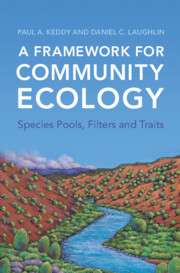Ant gardens (AGs) are specialized ant-plant associations where arboreal ants build their carton nests in association with epiphytes that use the carton as a substrate. Most of the epiphytes are planted by ants; therefore, seed selection by ants is a key driver of the epiphyte composition of AGs. However, deterministic post-dispersal factors, such as the surrounding environmental conditions and plant succession, may also influence epiphyte composition. Here we ask whether epiphyte composition on a local scale is associated with dispersal constraints, local environmental conditions (light availability, number of branches and nest height) or AG successional stage. We sampled all epiphyte species in 18 AGs formed by Camponotus femoratus and Crematogaster levior in Central Amazon, Brazil. AGs were located within a range of 1 km and at a maximum of 20 m from the edges of a dirt road within a primary forest. Epiphytic composition showed strong spatial structure, decreasing in similarity with increasing distance. Environmental conditions and AG successional stage were not related to AG floristic composition, suggesting a key role of stochastic processes related to seed dispersal. A combination of seed abundance and attractiveness in neighbouring AGs seems to drive the higher similarity in epiphyte composition among closer AGs.


